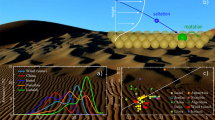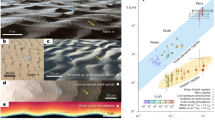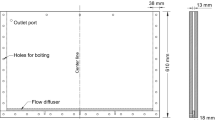Abstract
AEOLIAN ripples are distinguished by coarse-grained crests, finegrained troughs, and thin veneers of coarse grains on the upwind (stoss) slopes. Migration of these sorted bedforms during periods of net deposition results in a characteristic inversely graded stratigraphy that distinguishes aeolian sandstones from those of fluvial origin1. Here we investigate the formation and evolution of aeolian ripples using a cellular automaton model of a sandbed which incorporates two grain sizes and is subject to the impacts of episodically hopping (saltating) grains. Using this model, we identify the physical processes responsible for both the spatial sorting and the stratigraphic signature of the ripples. High-energy saltating grains are found to eject small grains preferentially from the impact site, leading to a coarsening of the heavily bombarded stoss slopes. Coarse grains do not in general leap far enough to escape the shadow zones on the downwind (lee) slopes, and therefore tend to accumulate and cycle around the ripple crests. Small grains, on the other hand, are ejected at higher velocities, enabling them to hop further. Incorporating net deposition into the model results in a stratigraphy closely resembling thin planar laminae ('pinstriping') found in aeolian sandstones: the inverse grading of grain sizes is a direct consequence of their different hop lengths.
This is a preview of subscription content, access via your institution
Access options
Subscribe to this journal
Receive 51 print issues and online access
$199.00 per year
only $3.90 per issue
Buy this article
- Purchase on Springer Link
- Instant access to full article PDF
Prices may be subject to local taxes which are calculated during checkout
Similar content being viewed by others
References
Hunter, R. E. Sedimentology 24, 361–387 (1977).
Hallet, B. Earth Sci. Rev. 29, 57–76 (1990).
Bagnold, R. A. The Physics of Blown Sand and Desert Dunes (Methuen, London, 1941).
Anderson, R. S. Sedimentology 34, 943–956 (1987).
Sharp, R. P. J. Geol. 71, 617–636 (1963).
Werner, B. T., Haff, P. K., Livi, R. P. & Anderson, R. S. Geology 14, 743–745 (1985).
Anderson, R. S. Earth Sci. Rev. 29, 77–96 (1990).
Forrest, S. B. & Haff, P. K. Science 255, 1240–1243 (1992).
Werner, B. T. thesis, California Inst. of Technol. (1987).
Haff, P. K. & Anderson, R. S. Sedimentology 40, 175–198 (1993).
Werner, B. T. J. Geol. 98, 1–17 (1990).
Anderson, R. S. & Haff, P. K. Science 241, 820–823 (1988).
Anderson, R. S. & Haff, P. K. Acta mech. (Suppl.) 1, 21–50 (1991).
Anderson, R. S. & Hallet, B. Geol. Soc. Am. Bull. 97, 523–535 (1985).
Anderson, R. S. & McDonald, R. R. Sedimentology (submitted).
Author information
Authors and Affiliations
Rights and permissions
About this article
Cite this article
Anderson, R., Bunas, K. Grain size segregation and stratigraphy in aeolian ripples modelled with a cellular automaton. Nature 365, 740–743 (1993). https://doi.org/10.1038/365740a0
Received:
Accepted:
Issue Date:
DOI: https://doi.org/10.1038/365740a0
This article is cited by
-
Coevolving aerodynamic and impact ripples on Earth
Nature Geoscience (2024)
-
Megaripple mechanics: bimodal transport ingrained in bimodal sands
Nature Communications (2022)
-
Aeolian sand sorting and megaripple formation
Nature Physics (2018)
-
Pattern formation in a horizontally shaken granular submonolayer
Granular Matter (2013)
-
The nonlinear theory for sediment ripple dynamic process of straight river
Science China Technological Sciences (2012)
Comments
By submitting a comment you agree to abide by our Terms and Community Guidelines. If you find something abusive or that does not comply with our terms or guidelines please flag it as inappropriate.



